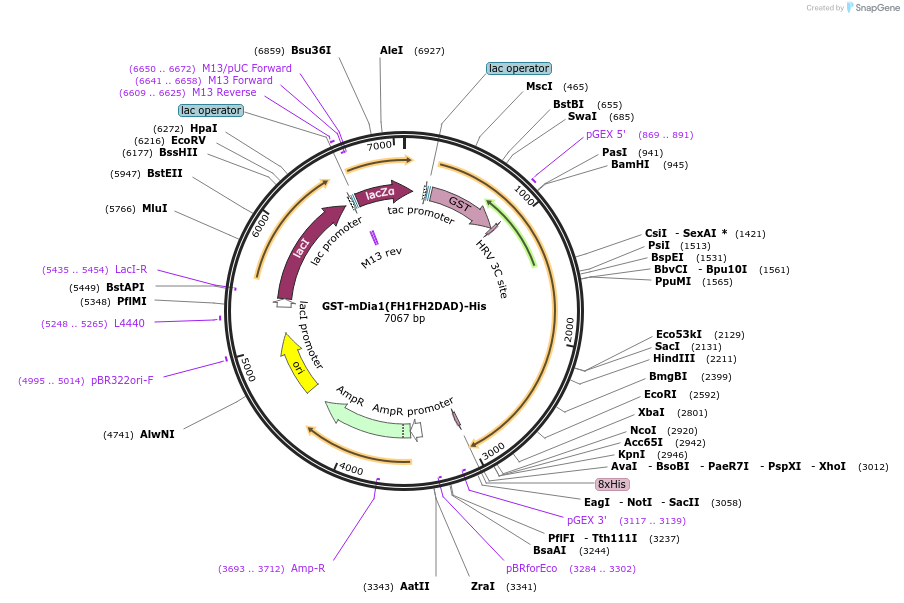GST-mDia1(FH1FH2DAD)-His
(Plasmid
#85822)
-
Purposecontains the formin homolgy domains: FH2 is required for nucleation, processive tracking of barbed-end of actin filaments ; FH1 permits enhancement of actin polymerization rate.
-
Depositing Labs
-
Sequence Information
Ordering
| Item | Catalog # | Description | Quantity | Price (USD) | |
|---|---|---|---|---|---|
| Plasmid | 85822 | Standard format: Plasmid sent in bacteria as agar stab | 1 | $85 | |
Backbone
-
Vector backbonemodified pGEX-6P-1
- Backbone size w/o insert (bp) 5003
- Total vector size (bp) 7067
-
Vector typeBacterial Expression
Growth in Bacteria
-
Bacterial Resistance(s)Ampicillin, 100 μg/mL
-
Growth Temperature37°C
-
Growth Strain(s)DH5alpha
-
Copy numberHigh Copy
Gene/Insert
-
Gene/Insert nameProtein diaphanous homolog 1
-
Alt namemDia1 (558-1255) FH1-FH2-DAD
-
SpeciesM. musculus (mouse)
-
Insert Size (bp)2064
-
Entrez GeneDiaph1 (a.k.a. D18Wsu154e, Dia1, Diap1, Drf1, p140mDia)
- Promoter tac
-
Tags
/ Fusion Proteins
- GST (N terminal on backbone)
- 8*His (C terminal on backbone)
Cloning Information
- Cloning method Restriction Enzyme
- 5′ cloning site BamHI (not destroyed)
- 3′ cloning site XhoI (not destroyed)
- 5′ sequencing primer CTGGCAAGCCACGTTTGG
- 3′ sequencing primer GGAGCTGCATGTGTCAGAG (Common Sequencing Primers)
Resource Information
-
Supplemental Documents
Terms and Licenses
-
Academic/Nonprofit Terms
-
Industry Terms
- Not Available to Industry
Trademarks:
- Zeocin® is an InvivoGen trademark.
These plasmids were created by your colleagues. Please acknowledge the Principal Investigator, cite the article in which the plasmids were described, and include Addgene in the Materials and Methods of your future publications.
-
For your Materials & Methods section:
GST-mDia1(FH1FH2DAD)-His was a gift from Antoine Jégou & Guillaume Romet-Lemonne (Addgene plasmid # 85822 ; http://n2t.net/addgene:85822 ; RRID:Addgene_85822) -
For your References section:
Formin mDia1 senses and generates mechanical forces on actin filaments. Jegou A, Carlier MF, Romet-Lemonne G. Nat Commun. 2013;4:1883. doi: 10.1038/ncomms2888. 10.1038/ncomms2888 PubMed 23695677

